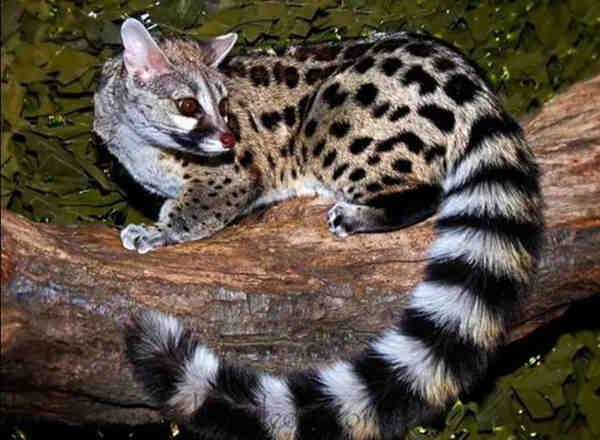Prionodon pardicolor
IUCN
LCBasic Information
Scientific classification
- name:Prionodon pardicolor
- Scientific Name:Prionodon pardicolor,Spotted Linsang, spotted civet cat, spotted civet cat, oriental civet cat, leopard cat, cunning cat, tiger civet cat
- Outline:Carnivora
- Family:Feliformes Lycopodidae
Vital signs
- length:35-40cm
- Weight:4.1-8kg
- lifetime:No verification yet
Feature
The difference between the spotted civet and other civets is that both sexes have no scent glands
Distribution and Habitat
Distributed in Bhutan, Cambodia, China, India, Laos, Myanmar, Nepal, Thailand, and Vietnam.
In China, it is distributed in Guangdong, Guangxi, Guizhou, Hunan, Jiangxi, Sichuan, Yunnan (Yingjiang, Bijiang, Gongshan, Menglian, Lancang, Mengla, Jinping, Maguan), and Tibet.
The spotted civet prefers evergreen broad-leaved rainforests, subtropical evergreen forests, and monsoon forests below 2,700 meters above sea level. It has also been reported to forage in human-disturbed forests and forest edge habitats.
Appearance
The skull is long and narrow, but the snout is shorter than that of other civets. The distance from the snout tip to the supraorbital process is only 38-44% of the total skull length. The postorbital region is approximately equal to the width of the interorbital region. The cranial cavity is large and oblong. There is a narrow narrow cranial region in front of the occipital bone. The temporal crests on both sides of the parietal bone never form sagittal crests. The tympanic cavity of the auditory bulla is higher than the auditory chamber and the paraoccipital process behind it. Teeth: The tooth cusps of the spotted civet are the most flattened and sharp among the Chinese civets, and are very similar to those of cats. The upper incisors are arranged in a straight line, the same as those of mongooses, mustelids and cats. The canine cusps are long. The premolars are high and sharp, almost flattened. The protocus of the upper carnassial teeth is extremely small and low, the anterior cusp i
Details
Spotted Linsang, whose foreign name is Spotted Linsang, is a medium-sized carnivore that mainly lives in forests. There are two subspecies.

There are two species of bandicoots, formerly classified as part of the family Viverridae, published in 2005 by Wozencraft, W.C. Order Carnivora. Wilson, D.E. & Reeder, D.M., The World's Mammalian Species: A Taxonomy and Geographical Reference" (3rd edition), identifying these two species as "spotted wood raccoon" and "striped wood raccoon" respectively, and have an independent family "Prionodontidae" (Prionodontidae). The International Union for Conservation of Nature Red List of Threatened Species (IUCN) 2015 and the Convention on International Trade in Endangered Species of Wild Fauna and Flora (CITES) 2019 have confirmed this classification and the new Chinese name.
There are two breeding seasons for the spotted forest civet, namely February and August. A single female can produce one to two litters per year. There are 2 pups in each litter. Newborns of spotted civets weigh 40 grams. Like most carnivores, the young of this species are naturally helpless and are hidden by their mother in cavities in trees or roots lined with dry vegetation, where they may remain until weaning.
The spotted civet mainly preys on small vertebrates (frogs, rodents, lizards), bird eggs, insects and berries. Arboreal, solitary, and nocturnal, it is rare throughout its distribution range. They spend most of their time in tree holes and will descend to the ground to feed. The fur of the spotted forest civet is dense, with few guard hairs and bright patterns, making the fur clothing beautiful and elegant. Because it feeds on rats, it can eliminate a certain number of rats, which has a certain effect on protecting ecological balance and agricultural production.
Although the spotted forest civet has a wide distribution range in China, its number is very rare. Among the tens of thousands of small carnivorous commercial furs purchased annually in Yunnan, China, only 20 are spotted civet furs, and even fewer in other provinces and regions. It can be seen that the spotted forest civet is endangered in my country and is a very rare species that needs priority protection (Schreiber, et. al., 1989). The original forests in China's spotted forest civet distribution areas have suffered a lot of damage, and their habitats have been greatly reduced, resulting in a decline in the number of spotted forest civets. In addition, hunting and killing, and the small original population base are also factors that endanger this species. In April 2022, the spotted forest civet, a national second-level protected wild animal, was discovered in the Tingjiangyuan National Nature Reserve in Fujian Province, which was the first record in Fujian Province.
Listed in the "World Conservation Union Red List of Threatened Species" (IUCN) 2015 ver 3.1 - Least Concern (LC).
Listed in Appendix I, Appendix II and Appendix III of the 2019 edition of the Convention on International Trade in Endangered Species of Wild Fauna and Flora (CITES).
It is included in the second level of China's "List of National Key Protected Wild Animals" (February 5, 2021).
Protect wild animals and eliminate wild game.
Maintaining ecological balance is everyone’s responsibility!








